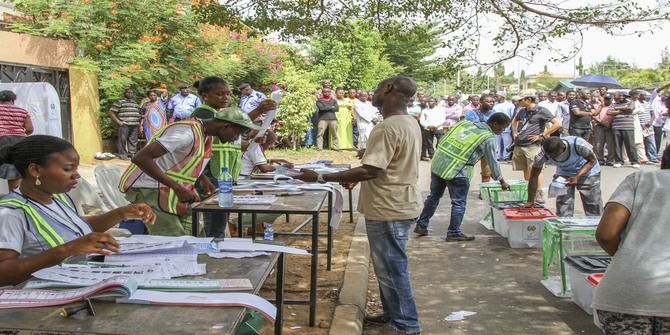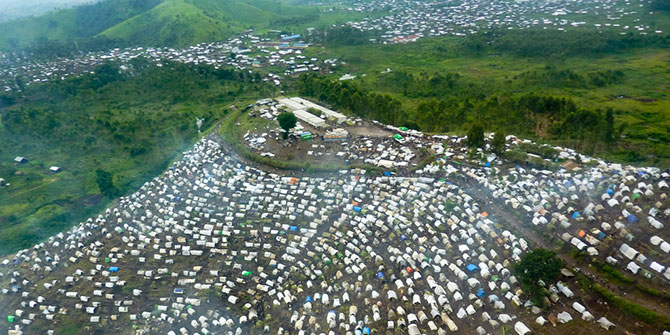Using the example of the village of Inke in Democratic Republic of Congo, Aaron Pangburn and José Ndala provide insight into how an inclusive approach and the support of host communities can improve the lives of displaced.
This article is part of our #LSEReturn series, exploring themes around Displacement and Return.
For the last five years, Inke, a small village, forty kilometres outside of Nord-Ubangi’s provincial capital Gbadolite in the Democratic Republic of Congo (DRC), has hosted between 15,000 and 20,000 refugees, who have fled violence from the Central African Republic. The Inke refugee camp is one of two camps in the province (the other is Bili Camp in the neighbouring Bosobolo territory), but these two facilities do not have the capacity or international funding to serve the entire refugee community crossing the border. For example, the United Nations High Commissioner for Refugees (UNHCR) one of the key international partners in the camp, received only 12 per cent of its 2017 requested budget to provide support to the Central African refugees in DRC, a funding gap of over $48 million dollars. Therefore, Congolese host families have had to shoulder much of the additional burden, and they have supported 10,683 refugees in nearby Gbadolite, and another 34,230 in surrounding communities in the territory of Mobayi Mbongo (where Inke is located).[1]

This on-going support is often a forgotten component of the refugee experience, especially as many governments and border communities in Europe and the US have recently retreated from their obligation to assist the displaced in times of conflict. In situations of protracted displacement, where refugees have no real prospect to return home, it is often the generosity of the host community and structures of cohabitation that sustain refugee populations.
Numbers continue to grow in Nord-Ubangi as violence escalates right across the Ubangi river border in CAR’s Basse Kotto prefecture, where the Union for Peace in the Central African Republic (UPC), the Central African Patriotic Movement (MPC), and by anti-balaka forces have clashed in recent months. This context has limited the potential for return for this group of refugees. In 2017, when conditions were a little more favourable, 47,735 refugees spontaneously returned to CAR, but the vast majority of these came from Cameroon. These settlements border the south west corner of the country, a region that has been identified as one of the only sufficiently peaceful and conducive regions for return (National Strategy, pg. 4). The national strategy for return, developed in consultation with the United Nations and Central African government, highlights that return should only occur if five primary conditions can be met:
- Consent of the host community
- Security
- Social cohesion
- Restoration of state authority
- Provision of basic socio-economic services
While this sort of environment is currently rare across the border in CAR, in Inke, the Congolese and Central Africans have been able to set up a number of formal and informal structures to establish a semblance of these conditions.
Inke and the Structures of Cohabitation
The camp is divided in six zones, six blocks and twenty-four communes, with an elected Chief for each of them. The National Refugees Commission (Commission Nationale des Réfugés, CNR) is in charge of the camp, which is overseen by a Congolese Administrator and a small rotating police force. There is also a Refugees Committee (Comité des Réfugiés) led by a directorate of five refugees of different ethnic groups and a number of subcommittees: education, conflict resolution, water and sanitation, social affairs, health, youth, sport, customary issues, security, women and elders.
After a May 2015 dispute over broken promises led to Congolese villagers barricading the entrance to the camp restricting humanitarian aid, a series of accords were negotiated and two key consultative bodies were set up to resolve disputes and reduce future tensions. A mixed committee of 12 refugees and 12 village residents, headed by the village chief handles mostly local land issues, while a more powerful conflict resolution body, entitled the Cadre de Concertation, handles larger disputes between the four premier public authorities: the Congolese government (represented by the Administrateur de Territoire and the CNR), village leadership, the Director of the Refugee Committee and UNHCR.
Land is loaned to the refugee families for cultivation, to engage in agricultural and livestock activities and to sell their produce at the local market at the entrance at the camp. This market has become a space for trade, coexistence, and daily exchange between the two populations. Cohabitation has also been reinforced by a number of marriages between the Central African refugees and Congolese further blurring the line between foreigner and local.
In terms of economic activity, peanuts are one of the primary products from Inke area, and the latest harvest is expected to produce more than 36 tons from 41 hectares of co-cultivated (Central African refugees and Congolese farmers) plants. A recent evaluation by REACH, an initiative of two international NGOs, concluded that due to communal regulation and sustainable exploitation, Inke is not at risk for a shortage of cultivable land despite the expansion of agricultural production, but there are still concerns from local authorities that in a few years there may be substantial damage to the land. Some refugees have also gained the right of mobility, and are able to travel to Gbadolite or nearby villages for fish or other daily necessities. In these types of environments of prolonged displacement, mobility is a lifeline, and provides the Central African refugees with a reference to normalcy that their prior lives once offered.
The purchasing power of the refugees has recently been improved by UNHCR and World Food Programme (WFP) by providing cash transfers and vouchers to purchase their preferred food items from local markets, instead of relying solely of the distribution of traditional aid items and rations. Refugees have been strategic and saved some of the most popular aid items such as rice, palm oil and salt and re-sold them in local markets, to the appreciation of local Congolese. This increased form of economic empowerment for the refugee community has improved a difficult situation, but by no means transformed their lives, as these transfers from July 2017 from WFP only equaled approximately $11 USD a month. Some refugees and their dependents have also expressed frustration at the frequency of being dropped from the “cash list”, and how reliant they have become on the promise of international assistance.
Prospects of Return
The promise of return still weighs heavily in the minds of many Inke residents, as they have been informed once again that if funding arrives in 2018, UNHCR might be able to organise their return. While return is driven by a desire to return home, it is also grounded in the status quo, the support that they are receiving, and the new land they are sharing with their Congolese neighbors. In the Politics of Return project, we often highlight the political environment and structures of authority the displaced must navigate upon their return, but it is crucial to analyse the arrangements and negotiated agreements with host communities that make displacement more manageable, especially in situations of extreme poverty and limited resources.
Although these structures that have been set up, some refugees still remain invisible, have not been able to integrate into the local economy, and continuously move back and forth across the river in search of stability. Even if return to their home communities is a bridge too far, international practitioners, researchers and NGOs should continue to support programs and reforms that offer refugees a relative return to normalcy. The experience of Inke in an underserved community in northwestern DRC shows that through dialogue, an inclusive approach can improve a difficult environment, but it must also be complemented by increased international support to create the necessary conditions for return.
Find out more about the Politics of Return and our Trajectories of Displacement research projects, which are based at the Firoz Lalji Centre for Africa and funded by ESRC/AHRC.
Aaron Pangburn (@panger55) is the Program Manager of the Social Science Research Council’s Understanding Violent Conflict Program (UVC).
Jose Ndala is a lecturer at the Université de Gbadolite in the faculty of law
The views expressed in this post are those of the author and in no way reflect those of the Africa at LSE blog, the Firoz Lalji Centre for Africa or the London School of Economics and Political Science.
[1] There is currently 90,758 Central African refugees in Nord-Ubangi province, and an additional 40,127 in neighboring Bas-Uele and 45,135 Sud-Ubangi provinces (UNHCR, 30 June 2018).





